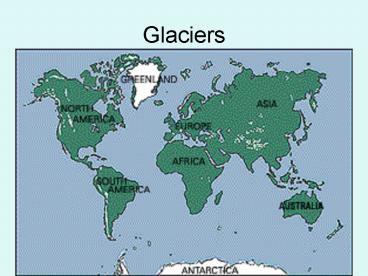Glaciers - PowerPoint PPT Presentation
1 / 32
Title:
Glaciers
Description:
... it develops solid ice layer (due to the ... Ice caps small ice sheets. The Snow Line ... Iceland's largest (8,200 square kilometers) ice cap, Vatnaj kull ... – PowerPoint PPT presentation
Number of Views:119
Avg rating:3.0/5.0
Title: Glaciers
1
Glaciers
2
What is a Glacier
- Glaciers are made up of fallen snow that, over
many years, compresses into large, thickened ice
masses. - Glaciers form when snow remains in one location
long enough to transform into ice
3
Za da Zan glacier
4
Birth of a Glacier
- In huge snow fields freshly fallen snow becomes
compressed and recrystallizes into a rough
granular ice material Firn - As the firn thickens it develops solid ice layer
(due to the compression of the snow on top of
them) - This ice then begins to flow downward or outward
due to the weight difference, this then becomes a
valley glacier.
5
How do they form?
6
Could you make a tiny one
- Since glaciers are formed from just snow the
answer is yes - Take a handful of snow and or crushed ice and
squeeze it between your hands
7
Different kinds of Glaciers
- Valley Glaciers long, wedge shaped stream of ice
that occupy mountain valleys - Continental glacier massive ice sheets that
move outward in all directions from a common
center
8
Valley Glaciers
- Also known as Alpine Glaciers
- These occur where mountains stretch above the
snow line. (Everywhere but Australia)
9
Continental Glaciers
- Also know as ice sheets
- These are found in Greenland and Antarctica.
- Nunataks inland great mountain peaks where ice
descends from the peaks - Ice caps small ice sheets
10
(No Transcript)
11
The Snow Line
- Snow line the lowest level that permanent snows
reach in the summer.
12
How do they move?
- What makes glaciers unique is their ability to
move. - Due to sheer mass, glaciers flow like very slow
rivers. - Some glaciers are as small as football fields,
while others grow to be over a hundred kilometers
long.
13
Movement of St. Franz Josef Glacier
- 1951 1957 1964
14
Transport Loose Rock
- Moraines - material carried in the bottom of the
glacier before it is deposited is called ground
moraines - Long lines that build up in the valleys are
called side (lateral) moraines - When two glaciers from one they form medial
(middle) moraines. - Ice fronts that move large pieces of rock are
called end moraines. - Rock flour is a mixture of fine sand and silt
formed by the crushing of rock under the glacier.
15
(No Transcript)
16
(No Transcript)
17
(No Transcript)
18
(No Transcript)
19
(No Transcript)
20
Glaciers leave their mark
- Striation show the general direction of the
movement of the glacier scratching the rocks as
they move over them. - Cirque a semicircular basin that is formed at
the head of the glacial valley - Arete when two cirques are formed next to each
other the divide between them may becomes narrow.
21
(No Transcript)
22
Striations
23
Cirques
24
Arete
25
(No Transcript)
26
Where are they?
- Presently, glaciers occupy about 10 percent of
the world's total land area, with most located in
polar regions like Antarctica and Greenland. - Glaciers can be thought as remnants from the
last Ice Age, when ice covered nearly 32 percent
of the land, and 30 percent of the oceans
27
An Ice Age?
- An Ice Age occurs when cool temperature endure
for extended periods of time, allowing polar ice
to advance into lower latitudes. - There has only been 8 ice ages scientist believe
in the past 750,000 years on Earth.
28
Will there be another Ice Age?
- Currently, the Earth is nearing the end of an
interglacial, meaning that another Ice Age is due
in a few thousand years. - This is part of the normal climate variation
cycle. Greenhouse warming may delay the onset of
another glacial era, but scientists still have
many questions to answer about climate change. - Although glaciers change very slowly over long
periods, they may provide important global
climate change signals.
29
Antarctica. The Byrd Glacier where it joins the
Ross Ice Shelf.
30
Malaspina Glacier, Alaska
31
Patagonian Ice Field, Chile and Argentina
32
Iceland's largest (8,200 square kilometers) ice
cap, Vatnajökull































